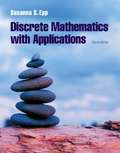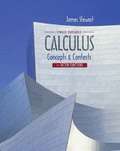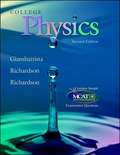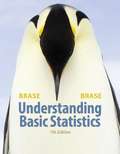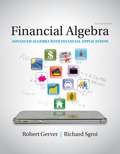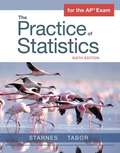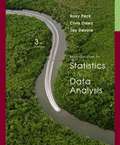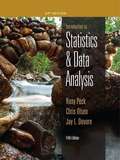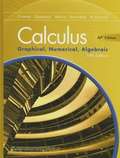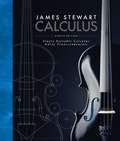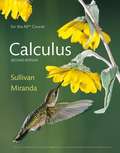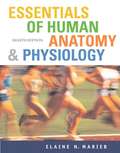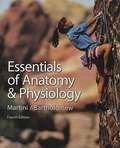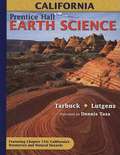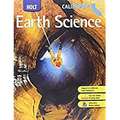Special Collections
District List: LAUSD High School Williams List of District Adopted and Approved Textbooks
- Table View
- List View
Discrete Mathematics with Applications
by Susanna S. EppNIMAC-sourced textbook
Susanna Epp's DISCRETE MATHEMATICS, THIRD EDITION provides a clear introduction to discrete mathematics. Renowned for her lucid, accessible prose, Epp explains complex, abstract concepts with clarity and precision. This book presents not only the major themes of discrete mathematics, but also the reasoning that underlies mathematical thought. Students develop the ability to think abstractly as they study the ideas of logic and proof. While learning about such concepts as logic circuits and computer addition, algorithm analysis, recursive thinking, computability, automata, cryptography, and combinatorics, students discover that the ideas of discrete mathematics underlie and are essential to the science and technology of the computer age. Overall, Epp's emphasis on reasoning provides students with a strong foundation for computer science and upper-level mathematics courses.
Advisory: Please be advised that the audio format is the only format working at this time. We apologize for any inconvenience and hope to have a fix soon.
COLLEGE Physics
by Alan Giambattista and Betty McCarthy Richardson and Robert C. RichardsonNIMAC-sourced textbook
Understanding Basic Statistics
by Charles Henry Brase and Corrinne Pellillo BraseNIMAC-sourced textbook
Understanding Basic Statistics
by Charles Henry Brase and Corrinne Pellillo BraseNIMAC-sourced textbook
Understanding Basic Statistics (Fourth Edition)
by Charles Henry Brase and Corrinne Pellillo BraseWelcome to the exciting world of statistics! We have written this text to make statistics accessible to everyone, including those with a limited mathematics background. Statistics affects all aspects of our lives. Whether we are testing new medical devices or determining what will entertain us, applications of statistics are so numerous that, in a sense, we are limited only by our own imagination in discovering new uses for statistics.
Precalculus with Limits with CalcChat® and CalcView®
by Ron Larson and Paul BattagliaNIMAC-sourced textbook
Precalculus
by Josea Eggink and Samantha Falkner and Emily Kaffel and Sarah MaileNIMAC-sourced textbook
SpringBoard Mathematics: Precalculus
by Betty Barnett and Allen Dimacali and John NelsonNIMAC-sourced textbook
The Practice of Statistics for the AP® Exam
by Daren Starnes and Josh Tabor and Ann Heath and Donald Gecewicz and Lumina DatamaticsNIMAC-sourced textbook
The Practice of Statistics for the AP® Exam
by Daren S. Starnes and Josh TaborAlong came Dan Yates. His vision for such a text became reality with the publication of The Practice of Statistics (TPS) in 1998. Over a million students have used one of the first five editions of TPS for AP® Statistics! Dan also championed the importance of developing high-quality resources for AP® Statistics teachers, which were originally provided in a Teachers' Resource Binder. We stand on the shoulders of two giants in statistics education as we carry forward their visions in this and future editions. The Practice of Statistics has continued to evolve, thanks largely to the support of our longtime editor and team captain, Ann Heath. Her keen eye for design is evident throughout the pages of the student and teacher's editions. More importantly, Ann's ability to oversee all of the complex pieces of this project while maintaining a good sense of humor is legendary. Ann has continually challenged everyone involved with TPS to innovate in ways that benefit AP® Statistics students and teachers. She is a good friend and an inspirational leader.
Introduction To Statisitcs and Data Analysis
by Roxy Peck and Chris Olsen and Jay DevoreNIMAC-sourced textbook
Introduction to Statistics and Data Analysis, AP® Edition
by Roxy Peck and Chris Olsen and Jay L. DevoreNIMAC-sourced textbook
Essentials of Human Anatomy and Physiology
by Elaine MariebEssentials of Human Anatomy and Physiology, Eighth Edition continues to set the standard for A&P texts by helping readers better visualize and understand the structure and function of the human body. New information on hot topics like DNA fingerprinting, bone implants for children, stem cell research, and obesity draws readers into the material. Elaine Marieb's clear and friendly writing style emphasizes the relevance of anatomy and physiology to readers' lives and careers. It clarifies concepts, defines key terms, and offers just the right balance of anatomy, physiology, and clinical coverage to make the content complete without being overwhelming.
Essentials of Anatomy and Physiology (4th Edition)
by Frederic H. Martini and Edwin F. BartholomewThis textbook is designed as an introduction to the specialized terms, basic concepts, and principles important to an understanding of the human body. It helps students place information in a meaningful context and develop their problem-solving skills. Thr text uses a learning system that simplifyies the processes of teaching and learning anatomy and physiology. The Visual Introduction outlines the pieces that make up our specific teaching framework and shows the many learning aids that are built into this text. The Fourth Edition also provides students and instructors with new media that will benefit their learning and teaching.
Conceptual Physics
by Paul G. HewittThis seventh edition of the popular and exceptionally well written physics concept text with minimal mathematics contains new material sprinkled throughout, such as a treatment of measurements of the earth, moon, and sun by the early Greeks, capacitors, and more on rainbows. Individual sections have been clarified and updated. Problem sets are now at the end of most chapters. Most problems involve simple calculations that require minimal algebra skills. The text is profusely illustrated in full color with many helpful diagrams and down-to-earth examples. Annotation C. by Book News, Inc., Portland, Or.
Conceptual Physics
by Paul G. HewittThis seventh edition of the popular and exceptionally well written physics concept text with minimal mathematics contains new material sprinkled throughout, such as a treatment of measurements of the earth, moon, and sun by the early Greeks, capacitors, and more on rainbows. Individual sections have been clarified and updated. Problem sets are now at the end of most chapters. Most problems involve simple calculations that require minimal algebra skills. The text is profusely illustrated in full color with many helpful diagrams and down-to-earth examples. Annotation c. by Book News, Inc., Portland, Or.
Earth Science (California Edition)
by Edward J. Tarbuck and Frederick K. LutgensThe California Earth Sciences strand is organized into ten general standard sets. The standard sets are Earth's Place in the Universe (Solar System), Earth's Place in the Universe (Stars, Galaxies, and the Universe), Dynamic Earth Processes, Energy in the Earth System (Solar Energy Enters, Heat Escapes), Energy in the Earth System (Ocean and Atmospheric Convection), Energy in the Earth System (Climate and Weather), Biogeochemical Cycles, Structure and Composition of the Atmosphere, California Geology, and Investigation and Experimentation. Each standard set is divided into a series of specific topic standards. Use this section as a preview for your Earth Science course, and as a review guide when you study for exams.
Holt Earth Science (California Edition)
by Mead A. Allison and Arthur T. Degatetano and Jay M. PasachoffThe book contains unit lessons on Studying the Earth, Composition of the Earth, History of the Earth, the dynamic Earth, reshaping the crust, Oceans, Atmospheric Forces, and Space.
Marine Science
by Thomas F. GreeneWritten for high school students, this book provides complete coverage of a one-year high school course in marine biology/oceanography.
